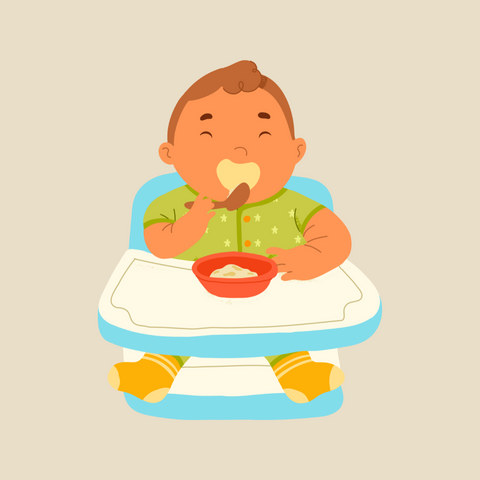
You can make your little one's highchair their happy place with these tips to encourage them to be comfortable and love all kinds of food you offer them. Every kid approaches food differently, and as a parent, you may need to try a few different techniques before they start to develop healthy eating habits. When your little one refuses to eat, they may be trying to tell you that they are ready to move on to new flavours and textures of baby food. So, now is the time to start expanding their horizons and promoting their eating independence. Here are a few tips to encourage your kids to develop healthy, positive relationships with food-

Offer them everything with colours & variety: Give your kids food with different flavours, textures, and health benefits like food items high in iron include iron-fortified cereals, millet mixes, dried beans, peas, and lentils. Eating iron-rich foods helps prevent iron deficiency and supports growth and brain development in them. Serve a fruit or vegetable at every meal and snack, it may not happen every time, but setting this goal means your kids will be guaranteed regular exposure to fruits and vegetables. Your kids will also grow up knowing that we eat veggies at all times of the day, not just at dinner (when many little kids are too fussy and tired to be receptive to new or challenging foods).

To make your kids love food, add variety and colour to the plate by:
- Serve them home-cooked meals with different vegetables to add flavour.
- Mixing mashed or pureed fruits into pancake batter.
- Serving food with different kinds of dips.
- Cutting fruits and vegetables into different shapes and arranging all the elements all together.
- Make the plate look interesting for your little one.
This way they will build interest in trying a variety of food items and will get nutrients that are important for growth, development, and learning.
Prioritize a calm table for your little ones: Bring on your family for the mealtime as family meals are about being together and connecting, not counting the number of bites the child takes.

Prioritizing a calm table for your kids is very important because:
- When you interfere less with their eating and focus on appreciating your meal, you are modeling healthy enjoyment of food and you are creating a safe, accepting, and happy eating environment for your kid.
- Sit and eat with your kid as you are your kid's best role model. Your kid will learn healthy eating habits by watching you.
- Turn off the TV, cell phones, tablets, and computers to allow your child to focus on eating and keep the family meal pleasant.
Offer your child the same healthy foods that you and the rest of your family enjoy.
Bring on Self-feeding: Self-feeding is a big milestone in the development of your little one, as it encourages them to explore food through their senses of touch, taste, sight, and smell.

Kids go through developmental stages as they learn to feed themselves:
- First, they learn to eat solids by taking food from a spoon or picking up food with their hands, then they move on to feeding themselves with spoons, forks, and cups.
- Give them lots of practice with smaller, bite-sized morsels of food to help them master important finger skills, and learn how to gum, chew and move food around in their mouth, all crucial skills for a developing eater.
Just when you thought mealtime couldn’t get any messier!
Communicate positive messages early to your little ones: Your little ones are building their language skills now, so take advantage of that by talking about food, you can create a positive environment around food when you lead by example. During mealtime, listen to your hunger cues and talk about them with your kid.
How do you know when you’re hungry or when you’re full? If you’re always going for seconds before you’ve finished your vegetables, your kid will want to as well. Talk about what you’re eating and why: We eat vegetables because they provide fiber, vitamins, and minerals that make our bodies feel strong. Lean proteins help muscle development.

You can talk to them like:
- "Let’s sit down to eat so we can enjoy it”
- Talk about hunger and fullness by asking, “Is your belly happy or is it still hungry?”
- If they don’t like what’s served, assure them, “I know you want pancakes, but we don’t eat the same things every day. We’ll have that again soon.”
They may not understand the meaning of everything you say, but you’re making the conversation about food, eating, and appetite a normal part of everyday life.
Whatever you do, don't let mealtime become battle time or you'll risk setting them up for future dinner-table duels. No matter how much they eat or refuse to eat and when they do feed themselves food, reinforce their decision by giving them plenty of praise and encouragement.
